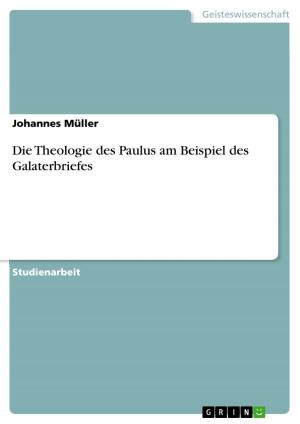7 deadly sins
Gulâ and Luxuria - an investigation of the sins of the flesh using the example of Geoffrey Chaucer's 'Parson's Tale'
Fiction & Literature, Literary Theory & Criticism, British| Author: | Julia Liese | ISBN: | 9783640953189 |
| Publisher: | GRIN Verlag | Publication: | July 7, 2011 |
| Imprint: | GRIN Verlag | Language: | English |
| Author: | Julia Liese |
| ISBN: | 9783640953189 |
| Publisher: | GRIN Verlag |
| Publication: | July 7, 2011 |
| Imprint: | GRIN Verlag |
| Language: | English |
Seminar paper from the year 2010 in the subject English - Literature, Works, grade: 1,3, Free University of Berlin, language: English, abstract: 'Whether we are willing to admit it or not, all of us are engaged, to some degree or another, in an ongoing battle with sin and vice.' (Dunnam and Dunnam Reisman 1 [in the following abbriviated as D&DR 1]) If this is the case, we need to become more aware of the 'important' sins and strive for as much knowledge about them as possible. Geoffrey Chaucer's Canterbury Tales. This collection of Middle English stories was written at the end of the 14th century. The different tales are told by pilgrims who are on a journey to the shrine of Saint Thomas Becket at Canterbury Cathedral. The most interesting story which is discussing the subject of sins, is the Parson's Tale. 'The theme of the Parson's Tale is Penitence, and it is treated under the three main heads of Contrition, Confession, and Satisfaction.' (Cooper 402) A 'large proportion of the Tale [is] taken up by the analysis, in the course of the Confession section, of the seven deadly sins.' (Cooper 402) The Parson claims that these seven sins are the source of all other sins, 'now been they cleped chieftaynes, for as much as they been chief and spryng of alle othere synnes' (Chaucer Verse 386 [in the following abbreviated by 'V386']) and therefore it is reasonable to focus on these when investigating the subject of sin. However, this paper is unfortunately bound to a very small number of words and can therefore not analyse all seven sins. It will therefore only focus on two, commonly known as the sins of the flesh: gluttony and lust. Consequently, the body of this paper is divided into two sections; each will examine the relevant part of the Parson's Tale. An overview of the receptions of the sins of the flesh in the Middle Ages and today will be given, in order to understand their gist. This will be done by combining old and new definitions, determining the subcategories and examining occurrences of the sins. Because the New Testament is a source which is frequently used by Chaucer, and to guarantee a complete understanding of the sin, each section will also analyse different sections of the bible. Besides that, the modern understanding of the sin will be discussed and each chapter will be closed off with a brief summary. Finally, the argumentation is rounded off with a conclusion that sums up the findings of this paper and the question of how much the perception of the sins of the flesh has changed over time will be answsered.
Seminar paper from the year 2010 in the subject English - Literature, Works, grade: 1,3, Free University of Berlin, language: English, abstract: 'Whether we are willing to admit it or not, all of us are engaged, to some degree or another, in an ongoing battle with sin and vice.' (Dunnam and Dunnam Reisman 1 [in the following abbriviated as D&DR 1]) If this is the case, we need to become more aware of the 'important' sins and strive for as much knowledge about them as possible. Geoffrey Chaucer's Canterbury Tales. This collection of Middle English stories was written at the end of the 14th century. The different tales are told by pilgrims who are on a journey to the shrine of Saint Thomas Becket at Canterbury Cathedral. The most interesting story which is discussing the subject of sins, is the Parson's Tale. 'The theme of the Parson's Tale is Penitence, and it is treated under the three main heads of Contrition, Confession, and Satisfaction.' (Cooper 402) A 'large proportion of the Tale [is] taken up by the analysis, in the course of the Confession section, of the seven deadly sins.' (Cooper 402) The Parson claims that these seven sins are the source of all other sins, 'now been they cleped chieftaynes, for as much as they been chief and spryng of alle othere synnes' (Chaucer Verse 386 [in the following abbreviated by 'V386']) and therefore it is reasonable to focus on these when investigating the subject of sin. However, this paper is unfortunately bound to a very small number of words and can therefore not analyse all seven sins. It will therefore only focus on two, commonly known as the sins of the flesh: gluttony and lust. Consequently, the body of this paper is divided into two sections; each will examine the relevant part of the Parson's Tale. An overview of the receptions of the sins of the flesh in the Middle Ages and today will be given, in order to understand their gist. This will be done by combining old and new definitions, determining the subcategories and examining occurrences of the sins. Because the New Testament is a source which is frequently used by Chaucer, and to guarantee a complete understanding of the sin, each section will also analyse different sections of the bible. Besides that, the modern understanding of the sin will be discussed and each chapter will be closed off with a brief summary. Finally, the argumentation is rounded off with a conclusion that sums up the findings of this paper and the question of how much the perception of the sins of the flesh has changed over time will be answsered.















